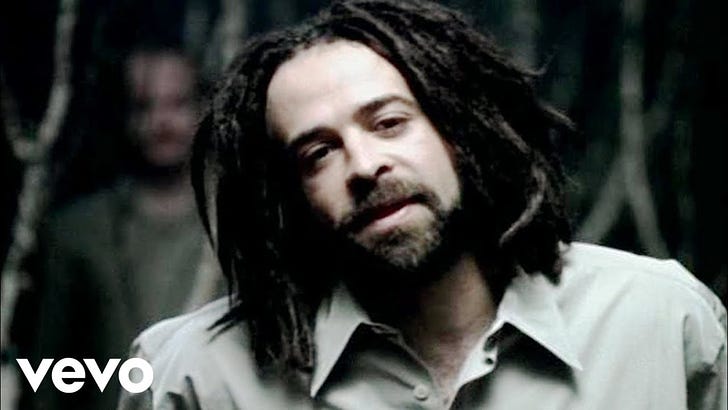A reminder, Michael Acoustic will be dark next Thursday and Friday for the Thanksgiving holiday. And I hope you find the gear you need on Black Friday, but more importantly, the inspiration to put it all to good use!!
Yesterday’s Bonus Round (since we won’t be doing a post next week): "A Long December" is a song by American alternative rock band Counting Crows. The ballad is the second single and 13th track from their second album, Recovering the Satellites (1996). Lead singer Adam Duritz was inspired to write the track after his friend was hit by a car, making the song about reflecting on tragedy with a positive disposition.
Released in December 1996, "A Long December" peaked at number five on the US Billboard Modern Rock Tracks chart and number one on the Canadian RPM Top Singles chart. In December 1997, the song was re-released in the United Kingdom and reached number 68, six places below its original peak of number 62. American Songwriter magazine named "A Long December" the best Counting Crows song in April 2022.[1]” Credit: Wikipedia "A Long December"
Saw this and it seemed to go well with some of the themes in yesterday’s links about home recording:
Yesterday I came across this from an article on the internet (Link below):
“To be considered an intermediate player, you’ll need to be able to do the following:
Know and be able to change smoothly between your fundamental open chords.
Know power chords and be able to move them around cleanly.
Know the basic Major and Minor bar chord shapes.
Know the note names on the Low E and A strings.
You’ll need to have all the basic strumming patterns down.
Be able to play along to a metronome.
Hear and match Major and Minor chords.
Hear and identify the keys of simple songs.
Understand music theory for keys and chords.
Play through several complete songs.
Play the Blues Scale.
Play the Major Scale.
Play the Major Pentatonic Scale.
Play the Minor Pentatonic Scale.
You’ll need to know basic lead technique: Picking, Bending, Sliding, & Vibrato.
Depending on your goals you may need to be able to read music.”
Credit: GuitarLessons.com Intermediate Player?
So, I agree completely with a number of those “criteria” (it helps a little to understand the site is offering to sell you lessons to teach you how to do all of those things, so the list might be a little on the ambitious side). Some of those are dependent on your choice of instrument and style of playing, but I would agree all of them are good “goals” for every intermediate player, but not necessarily “qualifiers”. I’m certainly going to pay some attention to the ones I know I’m not there yet on, but it’s not a priority. In fact it’s on the “I’ll get to that” list, some of which I never accomplish, but I’m satisfied with progress, albeit intermittent progress. Why would I not drop everything right now to master each of those? Frankly, I’m already an intermediate player within a range of what I consider necessary skills for the goals I want to accomplish. I’m kinda like “George” from “The Sultans Of Swing”:
“Check out guitar George
He knows all the chords
Mind, it's strictly rhythm
He doesn't want to make it cry or sing
Yes and an old guitar is all he can afford
When he gets up under the lights to play his thing”
Credit: Genius Lyrics app (and of course the incomparable Mark Knopfler, who wrote the song!)
That doesn’t mean I’m satisfied with that, nor will I ever be “satisfied” with my level of playing ability, but I am content with my current level, given my current goals of songwriting, which isn’t a skill peculiar to the guitar, and recording vocals (also not particular to guitar), and recording my accompanying guitar - which is very dependent on a certain skill level. Depending on the type or genre of music you want to play on guitar, and the type of guitar (acoustic or electric) you use most, many of those skills listed will be bedrock “must haves’ for every guitarist - especially if you’re playing with other musicians. For me, these skills are fundamental:
Change chords smoothly on the beat
Know the useful Major and Minor bar chord shapes that you have to for your style, otherwise, just understand how to use a capo and a capo conversion chart.
Know the note names on the Low E and A strings - I agree with this completely, and knowing which notes on the Low E and A strings are at the inlays on your fretboard is essential when you’re learning this skill until all the notes up and down the fretboard become rote memory. Barre chords become so much easier when you know which fret to lay your index finger across, and that comes from knowing where the root note of the barre chord is on the low E and A strings first then using the correct shape for your other fingers to complete the appropriate chord.
Using the go-to “Calypso” strum pattern (1, 2 and, [no 3 beat] and, 4 and) is a good basis - expand from that foundation. Here’s a previous post where I write about the Calypso beat strum, that will work at least 80% of the time as a place to start from:
Be able to play along to a metronome - absolutely critical skill. I find I “lose the click” sometimes when I’m recording - I get caught up in the chord change coming up, or a tricky chord, my attention goes there, and I’ve lost the timing. A couple of tricks of the trade: Logic Pro (and maybe other DAWs) let you see the count visually on the tracking screen - I make it huge enough to glance at as it counts beats numerically on the screen. It’s helpful if I’ve lost the click momentarily and I can look over and know where I’m at in the count for that measure without waiting for the polyphonic “1” beat to come around on the click. Another tip (thanks Mellad!): add a stock drummer loop track (delete it after you get a great track) with a pattern at your tempo timing you hear as maybe a “kick snare kick crash” or some other recognizable pattern so even if you loose the “1” beat click you know from the pattern where you are in the measure.
“Hear and” - nope - I’m happy to use the .pdf function in the Chordify app as a crutch to see the Key, Time and Tempo of a song, but be careful - the Key signature may be for a Major key, but it also may indicate the relative minor key - the Circle of Fifths is a handy reference - I use it as the “home screen” wallpaper on my iPhone.
Understand music theory for keys and chords - another absolute must, at least to the extent that you can communicate with other musicians in this “language” of music. Reading a score can be helpful to picking out or learning a melody, but not as universally useful as an understanding of Keys (including the underlying scale formula), how to construct triad chords and 7th chords from the underlying scale roots, and chord extensions and alterations such as suspended and “add” chords. - all stuff covered in previous post on Michael Acoustic - check out the “Retrospectives” posts from this summer at the michaelfab.substack.com/archive (Archive) to find links with subject information that may be useful.
Playing the scales and lead guitarist techniques are “should haves” depending on your genre tastes - for a vast amount of country, folk, Americana, and pop songs as a rhythm guitarist they aren’t necessary to qualify as an “intermediate player” - but that doesn’t mean ignore them. Put them on the list and learn them. For instance, I can play through all the pentatonic boxes in some minor keys. And I never use that skill at all. Probably should. Not today.
So, enough for now, have a great Thanksgiving holiday next week and we’ll be back in December!
Cheers, and keep playing!!
Michael Acoustic






